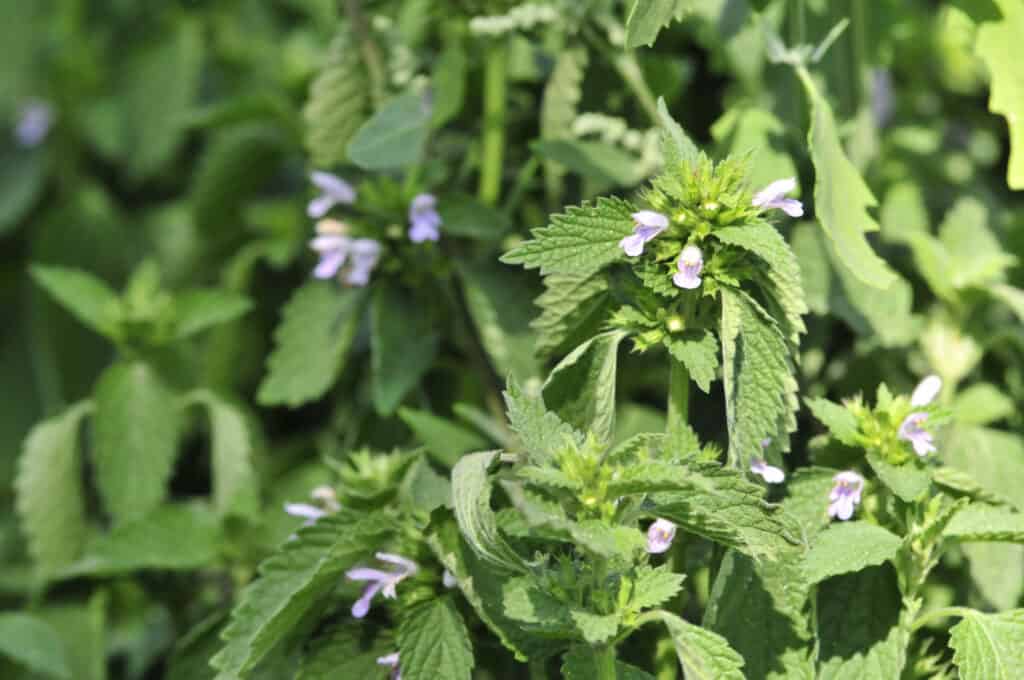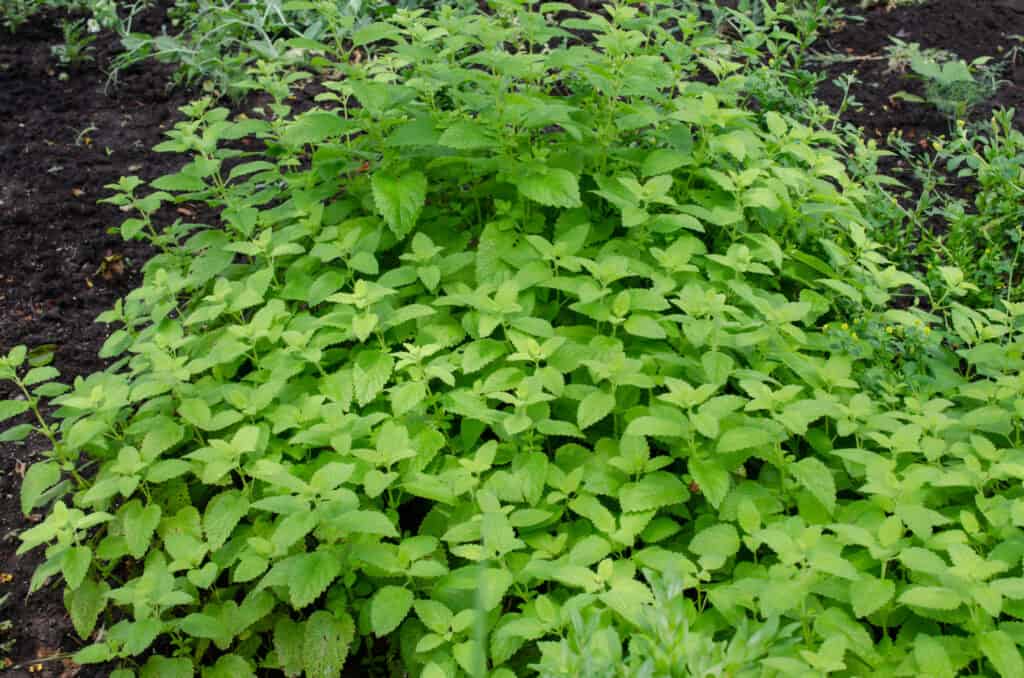If you enjoy the wonderful aroma of lemons, you might be interested in plants with leaves that produce this lemony scent. When comparing lemon balm vs. lemon verbena, you’ll find that both of these lovely deciduous, flowering plants produce a potent lemon fragrance. However, you’ll find that the similarities between these two plants generally end with their similar names, aromas, and uses based on their aromatic properties.
In this guide, we’ll discuss the similarities and differences between lemon balm and lemon verbena, including their plant classifications, plant characteristics, native ranges and growing conditions, landscape uses, and potential medicinal uses.
So, without further ado, let’s jump into the wonderful world of these aromatic plants.
Lemon Balm vs. Lemon Verbena: A Quick Look
| Lemon Balm | Lemon Verbena | |
|---|---|---|
| Plant Classification | Melissa officinalis | Aloysia citrodora |
| Plant Characteristics | A bushy herbaceous perennial in the mint family. Grows to 1-2 feet tall with a 2–3-foot spread. Leaves grow in pairs opposite to one another. They are wrinkled, heart to ovate-shaped, serrated along the margin, and distinctly veined. Leaves become gradually smaller as they ascend the stalk. They have a pleasant lemony fragrance. The stem has 4 distinct edges and is finely haired. Produces tiny, white flowers. | A woody, perennial shrub. Can grow up to 15 feet tall and 20 feet wide. Leaves are lanceolate-shaped and heavily lemon scented. Leaves are shiny, oppositely arranged and reach 3-4 inches long. It produces small white flowers. |
| Native Range and Ideal Growing Conditions | Native to Southern Europe and Northern Africa. Has become naturalized in temperate regions around the world. Prefers to grow in partial shade. Prefers well-draining, loamy, fertile soil with a pH of 6.5-7.0. Will tolerate most soil types outside of its ideal growing conditions. | Native to Chile and Argentina. Prefers to grow in full sun. Prefers well-draining, fertile soil. Does not tolerate poorly draining soil as it will suffer root rot. |
| Landscape Uses | Great for use to fill in shadier areas of a landscape. Aromatic lemon scent can repel various unwanted insects such as flies and mosquitos. | Wonderful as a landscape shrub for its lovely lemony scent and pretty white flowers. Often planted where people will brush against the plant to release lemon scent of the leaves. Strong scent repels unwanted insects such as flies and mosquitos. |
| Medicinal Uses | Lemon balm has a rich history of medicinal use in ancient Egypt, Greece, and Rome. Historical uses include mood boosting, stress reduction, sleep promotion, gastric protection, and anti-dizziness. Current research supports the ancient medicinal use of lemon balm for the above-mentioned effects. | Historically used for digestive disorders, insomnia, skin conditions, candida infections, and joint pain. |
Plant Classification
While both of these plants’ leaves have a strong lemon scent and taste, they belong to entirely different botanical families. Lemon balm (Melissa officinalis) is a perennial herb that belongs to the mint family Lamiaceae. However, lemon verbena (Aloysia citrodora) is a woody shrub that belongs to the family Verbenaceae.
Lemon Balm vs. Lemon Verbena: Plant Characteristics
While lemon balm and lemon verbena have similar common names and share similar aromatic properties, they are vastly different-looking plants. You shouldn’t have trouble at all distinguishing these two plants given that the height and width of shrubby lemon verbena is considerably larger than the much smaller, herbaceous lemon balm.
Lemon balm has plant characteristics typical of herbs in the mint family. The plant is herbaceous, has a squared stem, leaves that grow in pairs oppositely arranged, and produces flowers that are tiny and tubular. Lemon balm grows to a height of about 1-2 feet with a 2-3-foot spread, giving the plant a bushy appearance. The leaves are wrinkled, prominently veined, heart-shaped to ovate-shaped, and serrated along the margins. The leaves have a strongly aromatic lemon scent. This plant is sometimes confused with bee balm, a similar-looking plant (when not flowering) that is also in the mint, Lamiaceae, family.
In contrast to the herbaceous lemon balm, lemon verbena is a woody shrub that can grow up to 15 feet high and 20 feet wide. Like lemon balm, its leaves produce a strongly aromatic lemon scent. The leaves are shiny and narrowly lanceolate-shaped with a glossy sheen. It produces tiny white flowers on the stalk at the top of the plant. Conversely, lemon balm produces flowers all along the length of the stalk.

Lemon balm (
Melissa officinalis) leaves are wrinkled, prominently veined, heart-shaped to ovate-shaped, and serrated along the margins.
©iStock.com/petrovaliliya
Native Range and Ideal Growing Conditions
Regarding their native ranges, lemon balm and lemon verbena natively grow in entirely different regions of the world. Lemon balm is native to Southern Europe and Northern Africa, while lemon verbena is native to the South American countries of Chile and Argentina. However, gardeners cultivate both plants outside of their native range in suitable regions. Lemon balm, due to its culinary, medicinal, and ornamental use, has been particularly widely cultivated in temperate regions around the world.
Lemon balm prefers to grow in well-draining, loamy, fertile soil with a slightly acidic to neutral pH of 6.5-7.0. Notably, lemon balm will tolerate a wide range of soil types out of its ideal conditions. It prefers to grow in full sun and thrives in USDA Hardiness Zones 3-7.
Like lemon balm, lemon verbena prefers to grow in well-draining, fertile soil. However, it does not thrive in soggy conditions and will quickly develop root rot if grown in poorly draining soil with high moisture retention. Lemon verbena prefers full sun, does not handle cold weather well, and will drop its leaves and enter dormancy once temperatures dip to 40 degrees Fahrenheit. In its ideal growing zones, lemon verbena is an evergreen. As a warmth-loving plant, lemon verbena grows best in USDA Hardiness Zones 8-11.

Lemon verbena (
Aloysia citrodora) leaves are shiny and narrowly lanceolate-shaped with a glossy sheen.
©Skyprayer2005/Shutterstock.com
Lemon Balm vs. Lemon Verbena: Landscape Uses
Both lemon balm and lemon verbena are popular deciduous landscape plants for their wonderful lemony fragrance. They are both often planted where people are likely to brush against the leaves and send the lemon fragrance wafting through the air. Indeed, people value their lemon aromas not only for the pleasant smell but also as a deterrent against insects such as mosquitos and flies.
So, if you’re growing an herb garden, consider growing a border of lemon balm around your garden as this can act as a powerful insect deterrent. This insect-repellant border can also work with lemon verbena but note that careful planning is needed to allow room for the size this shrub will reach at maturity.

Lemon balm (
Melissa officinalis) can be planted in your garden as a powerful insect deterrent.
©iStock.com/Allchonok
Medicinal Uses
Traditionally, people have used both plants for medicinal uses. Lemon balm in particular has a rich history of use in North Africa, the Mediterranean, and the Middle East for mood-boosting, anti-dizziness, gastrointestinal problems, stress relief, and sleep promotion. Currently, a notable amount of research supports the use of lemon balm for these effects. One literature review of studies on lemon balm found that chemicals in lemon balm have anti-anxiety, anti-viral, and antioxidant effects. Furthermore, another scientific review of the literature concluded that lemon balm could be used to treat some neurodegenerative diseases, gastrointestinal diseases, and sleep disorders.
Indeed, similar to lemon balm, lemon verbena has a rich history of traditional medicinal use by the peoples of Chile and Argentina. Historically, people have used lemon verbena for digestive problems, insomnia, skin conditions, candida infections, and joint pain. Currently, a limited amount of research does suggest that lemon verbena can be useful in treating the problems described above. For example, one study determined that chemicals in lemon verbena are useful against Candida albicans, supporting the traditional use of this plant against candida infections. This study also found that lemon verbena is more potent against MRSA (Methicillin-Resistant Staphylococcus aureus) than Ciprofloxacin and Ampicillin.
Up Next
- Is Lemon Balm A Perennial Or Annual?
- Citronella vs Lemon Balm: What Are The Differences?
- Lemon Balm vs. Mint: How Are They Different?
The photo featured at the top of this post is © iStock.com/Nikolay_Donetsk
Sources
- NC State Extension, Available here: https://plants.ces.ncsu.edu/plants/melissa-officinalis/
- NC State Extension, Available here: https://plants.ces.ncsu.edu/plants/aloysia-citriodora/
- Missouri Botanical Garden, Available here: https://www.missouribotanicalgarden.org/PlantFinder/PlantFinderDetails.aspx?kempercode=c962
- Sage Journals, Available here: https://journals.sagepub.com/doi/full/10.1177/2156587216663433
- ScienceDirect, Available here: https://www.sciencedirect.com/science/article/abs/pii/S0378874116302732
- CORE, Available here: https://core.ac.uk/download/pdf/270255274.pdf
- BMC, Available here: https://bmccomplementmedtherapies.biomedcentral.com/articles/10.1186/s12906-021-03314-1
Thank you for reading! Have some feedback for us? Contact the AZ Animals editorial team.






